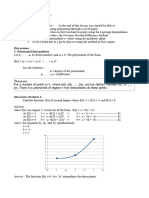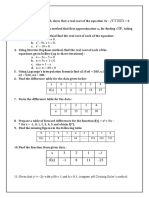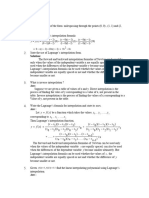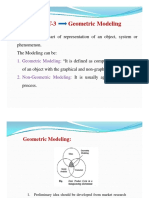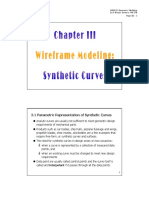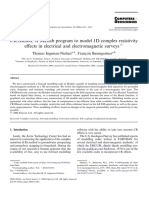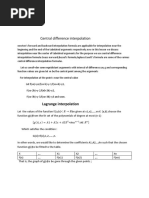Assignment 1
Uploaded by
Tarzan GhimireAssignment 1
Uploaded by
Tarzan GhimireAssignment 1
CHAPTER 4: INTERPOLATION
1. Use appropriate interpolation techniques to find y(x) and estimate y(15) and y(85) from the following data:
x 10 30 50 70 90
y 34 56 45 23 36
2. Use: a) Gauss’ forward &
b) Gauss’ backward formula to evaluate y25, given that y20 = 24, y24 = 32, y28 = 35, y32 = 40
3. Write Stirling’s formula and use it to find u42, given that u30 = 49225, u35 = 48316, u40 = 47236,
u45 = 45926, u50 = 44306.
4. From the following data, estimate the number of items having price between Rs. 2000-2500 using Bessel’s
Formula.
Price in Rs. 0-1000 1000-2000 2000-3000 3000-4000 4000-5000
No. of items 114 220 325 434 535
5. a) Write a pseudocode to interpolate the given sets of data using Lagrange’s Interpolation.
b) Obtain the Lagrange’s polynomial f(x) and find the missing term in the table given below:
Year 2005 2007 2008 2010 2015
Profit in Crores 43 65 ? 160 250
6. Use Newton’s divided difference formula to find f(x) and calculate f(3) from the given data:
f(0)=1, f(1)=14, f(2)=15, f(4)=5, f(5)=6, and f(6)=19.
7. What is the practical significance of the least squares method of curve fitting? Derive the normal
equations to fit a given set of data to a linear equation: y = ax + b.
8. Fit a second-degree polynomial function to the following data:
x 2 4 6 8 10 12 14
y = f(x) 20.4 18.6 18.1 16.5 15.9 17.4 19.3
9. The variables t and s are connected by the relation: t = a + becs and their corresponding values are given
in the following table. Find the best possible values of a, b and c.
s 1 2 6 8 11
t 12.7 12.5 11.6 11.3 11
10. Use least squares method to fit the given data using the model: y = ax + b + c/x.
x 0 5 10 15 20 25
y 12 15 17 22 24 30
11. Find y at x = 4.5 from the following data using Natural Cubic Spline interpolation.
x 1 3 5 7 9
y 10 12 11 13 9
12. Compute y’(3.5) from the following data using Cubic Spline Interpolation.
x 1 2 3 4
y 1 5 11 8
Date of Submission: 2079/10/13
You might also like
- Padmasri Dr.B.V.R.I.C.E List of Important Questions For Mathematics Paper-IvNo ratings yetPadmasri Dr.B.V.R.I.C.E List of Important Questions For Mathematics Paper-Iv8 pages
- Time: 3 Hours Max. Marks: 70 Note: Be Precise in Your Answer. in Case of Numerical Problem Assume Data Wherever Not ProvidedNo ratings yetTime: 3 Hours Max. Marks: 70 Note: Be Precise in Your Answer. in Case of Numerical Problem Assume Data Wherever Not Provided2 pages
- Curve Fitting: (X, Y) Through (X, Y) Is To Predict The Value of y When The Value of X Is Specified. ThereNo ratings yetCurve Fitting: (X, Y) Through (X, Y) Is To Predict The Value of y When The Value of X Is Specified. There9 pages
- Final Qb_module2_interpolation and ApproximationNo ratings yetFinal Qb_module2_interpolation and Approximation4 pages
- Numerical Methods QB 11148S51B 12148S51BNo ratings yetNumerical Methods QB 11148S51B 12148S51B10 pages
- CBNST QUESTION BANK (2012-2013 Session) CSE-2nd YearNo ratings yetCBNST QUESTION BANK (2012-2013 Session) CSE-2nd Year3 pages
- TOPIC 4 - Curve Fiiting and InterpolationNo ratings yetTOPIC 4 - Curve Fiiting and Interpolation23 pages
- Numerical Methods Chapter Three Curve Fitting: Woldia University Institute of TechnologyNo ratings yetNumerical Methods Chapter Three Curve Fitting: Woldia University Institute of Technology22 pages
- Ma1251-Numerical Methods Unit - I Solutions of Equations and Eigenvalue ProblemsNo ratings yetMa1251-Numerical Methods Unit - I Solutions of Equations and Eigenvalue Problems13 pages
- ASSIGNMENT: Numerical Analysis Submitted To: Miss Sidra Ayub Submitted byNo ratings yetASSIGNMENT: Numerical Analysis Submitted To: Miss Sidra Ayub Submitted by7 pages
- Curve Fitting, B-Splines & ApproximationsNo ratings yetCurve Fitting, B-Splines & Approximations14 pages
- BCS-054 Bachelor in Computer Applications Term-End Examination Jurte, 2014 Bcs-054: Computer Oriented Numerical TechniquesNo ratings yetBCS-054 Bachelor in Computer Applications Term-End Examination Jurte, 2014 Bcs-054: Computer Oriented Numerical Techniques4 pages
- BCS-054 Bachelor in Computer Applications Term-End Examination Jurte, 2014 Bcs-054: Computer Oriented Numerical TechniquesNo ratings yetBCS-054 Bachelor in Computer Applications Term-End Examination Jurte, 2014 Bcs-054: Computer Oriented Numerical Techniques4 pages
- Numerical Methods QB 11148S51B 12148S51BNo ratings yetNumerical Methods QB 11148S51B 12148S51B10 pages
- Unit 2: Numerical Methods Branches: EEE/ECE/TCE/ML/IT: Solution of Algebraic and Transcendental Equations100% (2)Unit 2: Numerical Methods Branches: EEE/ECE/TCE/ML/IT: Solution of Algebraic and Transcendental Equations10 pages
- Factoring and Algebra - A Selection of Classic Mathematical Articles Containing Examples and Exercises on the Subject of Algebra (Mathematics Series)From EverandFactoring and Algebra - A Selection of Classic Mathematical Articles Containing Examples and Exercises on the Subject of Algebra (Mathematics Series)No ratings yet
- Elements of Causal Inference: Foundations and Learning AlgorithmsFrom EverandElements of Causal Inference: Foundations and Learning AlgorithmsNo ratings yet
- A Brief Introduction to MATLAB: Taken From the Book "MATLAB for Beginners: A Gentle Approach"From EverandA Brief Introduction to MATLAB: Taken From the Book "MATLAB for Beginners: A Gentle Approach"2.5/5 (2)
- Audibility and Interpolation of Head-Above-Torso Orientation in Binaural TechnologyNo ratings yetAudibility and Interpolation of Head-Above-Torso Orientation in Binaural Technology12 pages
- CAD CAM Unit - 3 PPT-ilovepdf-compressedNo ratings yetCAD CAM Unit - 3 PPT-ilovepdf-compressed66 pages
- 3.3 Boundary Condition Locations: Ctran/W Chapter 3: Boundary ConditionsNo ratings yet3.3 Boundary Condition Locations: Ctran/W Chapter 3: Boundary Conditions36 pages
- CR1Dmod: A Matlab Program To Model 1D Complex Resistivity Effects in Electrical and Electromagnetic SurveysNo ratings yetCR1Dmod: A Matlab Program To Model 1D Complex Resistivity Effects in Electrical and Electromagnetic Surveys9 pages
- Parametric NURBS Curve Interpolators A Review100% (1)Parametric NURBS Curve Interpolators A Review9 pages
- Prediction of PM2.5 and PM10 in Chiang Mai Province A Comparison of Machine Learning ModelsNo ratings yetPrediction of PM2.5 and PM10 in Chiang Mai Province A Comparison of Machine Learning Models4 pages
- Basic Curves and Surface Modeling - CADNo ratings yetBasic Curves and Surface Modeling - CAD69 pages
- Common Catia or Unigraphics Interview QuestionNo ratings yetCommon Catia or Unigraphics Interview Question52 pages
- Lecture06 - Interpolation by Spline FunctionsNo ratings yetLecture06 - Interpolation by Spline Functions39 pages
- ELG5124-3D ObjectModelling-TR-01-2003-Cretu PDFNo ratings yetELG5124-3D ObjectModelling-TR-01-2003-Cretu PDF27 pages
- Using JMeter To Performance Test Web ServicesNo ratings yetUsing JMeter To Performance Test Web Services11 pages
- Get Classical and Modern Numerical Analysis Theory Methods and Practice 1st Edition Azmy S. Ackleh (Author) PDF ebook with Full Chapters Now100% (11)Get Classical and Modern Numerical Analysis Theory Methods and Practice 1st Edition Azmy S. Ackleh (Author) PDF ebook with Full Chapters Now73 pages




































